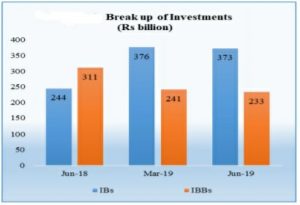Karachi
The Islamic banking and finance sector in Pakistan continues to be on an upward trajectory, with assets, deposits and the number of branches of Islamic banks all showing solid growth. According to the latest Islamic Banking Bulletin issued by the State Bank of Pakistan, assets of Pakistan’s Islamic banking industry stood at Rs2,992bn ($19.8bn) by June-end, 2019, a growth of 20.6% as compared to June-end, 2018. Similarly, overall deposits of Islamic banking customers witnessed growth of 18.8% in the period and reached Rs2,415bn ($15.4bn).
This translates into a market share of Islamic banking assets and client deposits in the overall banking industry of 14.4% and 15.9%, respectively, by the end of June, 2019, as compared to 12.9% and 14.8%, respectively, a year ago. On a half-year basis, Islamic deposits have grown 21% through June 2019, outpacing the 11% compound annual growth rate of all other deposit types in the banking sector.
According to the bulletin, the network of Islamic banks currently consists of 22 institutions, including five fully-fledged Islamic banks and 17 conventional banks with standalone Islamic banking branches. Among the Islamic banks, the largest is Meezan Bank with 678 branches, followed by Bank Islami Pakistan with 218 branches, Dubai Islamic Bank Pakistan with 200 branches, AlBaraka Bank (Pakistan) with 183 branches and MCB Islamic Bank with 177 branches. The largest banks with standalone branches, so-called Islamic windows, are Faysal Bank, National Bank of Pakistan, Bank Alfalah, Allied Bank and United Bank. The entire branch network of Pakistan’s Islamic banking industry stood at 2,913 spread across 113 districts by June-end, 2019, as compared to 2,685 a year ago. More than 77% of the branches were concentrated in Punjab and Sindh provinces. The number of Islamic banking windows stood at 1,348.

But it is not only the sheer size of the industry which is an important measurement, but clearly also the profitability of the banks.
Profit before tax of Islamic banks in Pakistan was recorded at slightly more than Rs32bn ($204mn) in the quarter ended June, 2019 compared to Rs15bn ($95.6mn) in the same quarter last year. Profitability ratios such as return-on-assets and return-on-equity before tax stood at 2.3% and 35.3%, respectively, by June-end, 2019, comparing favourably to industry figures of 1.6% and 21.3%, respectively. During the period under review, operating expense to gross income ratio witnessed further improvement and was recorded at 52.6%, compared to 54.7% in the previous quarter and lower than the industry total of 57.1%.
In terms of financing, the corporate sector accounted for a 73.5%-share in overall financing of Pakistan’s Islamic banking industry, followed by commodity financing with a share of 10.6% and consumer financing with 10.4%. The shares of small and medium enterprises financing and agriculture financing in overall financing stood at 3.7% and 0.5%, respectively.
Sector-wise, production and transmission of energy retained the leading position at a share in overall Islamic financing of 17.9%, followed by the textile and individual financing sectors, both having had a respective share of 11.6% by June-end, 2019. The most popular financing types were diminishing musharaka, followed by musharaka and murabaha.
The report also noted that much of the growth in Pakistan’s Islamic banking industry came from new retail customers on a market were 79% of a 197mn-population are still unbanked.
“The potential for Islamic banking penetration (in Pakistan) is substantial,” Moody’s Investors Service said in a separate report, adding that “Islamic banking products are attracting previously unbanked customers, creating new business opportunities for banks to grow their deposit base and benefit from stronger profitability.”
The State Bank of Pakistan has now set a goal to increase Islamic assets to 20% from the current 14.4%, helped by lifting structural and regulatory barriers, increasing awareness for Shariah-compliant banking and regular sukuk issuances.—Gulf Times










